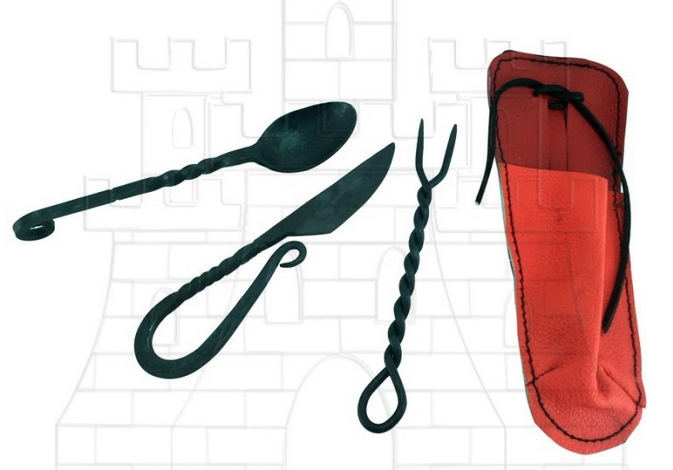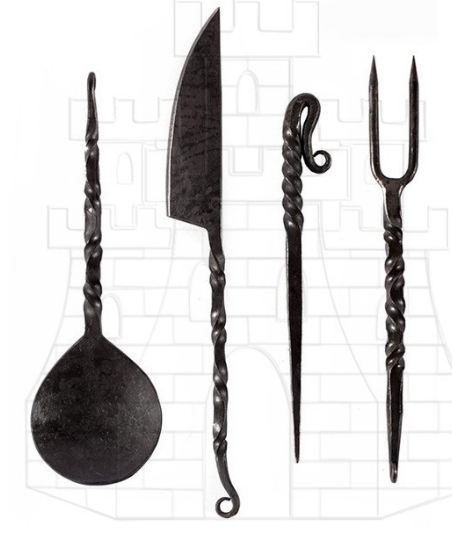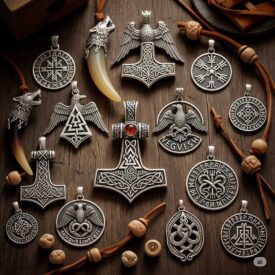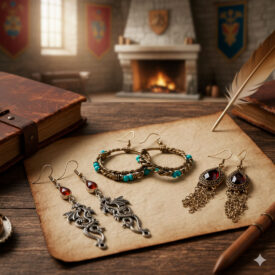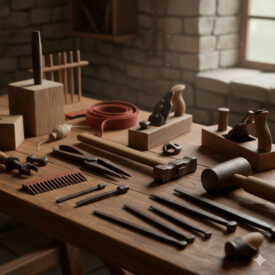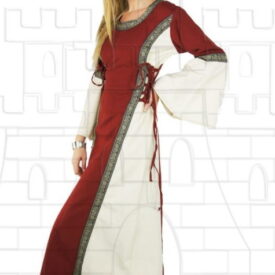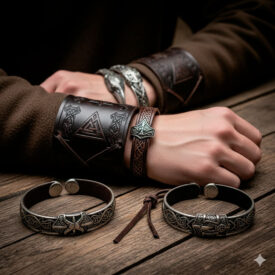The table in the Middle Ages was much more than just a place to eat; it was a mirror of society, reflecting its complex hierarchy and intricate rituals. In this context, medieval cutlery was not merely utensils, but tangible symbols of status and wealth. This article invites you to explore the fascinating evolution of cutlery used in the Middle Ages, from humble wooden instruments to the luxurious pieces that decorated the tables of the nobility.
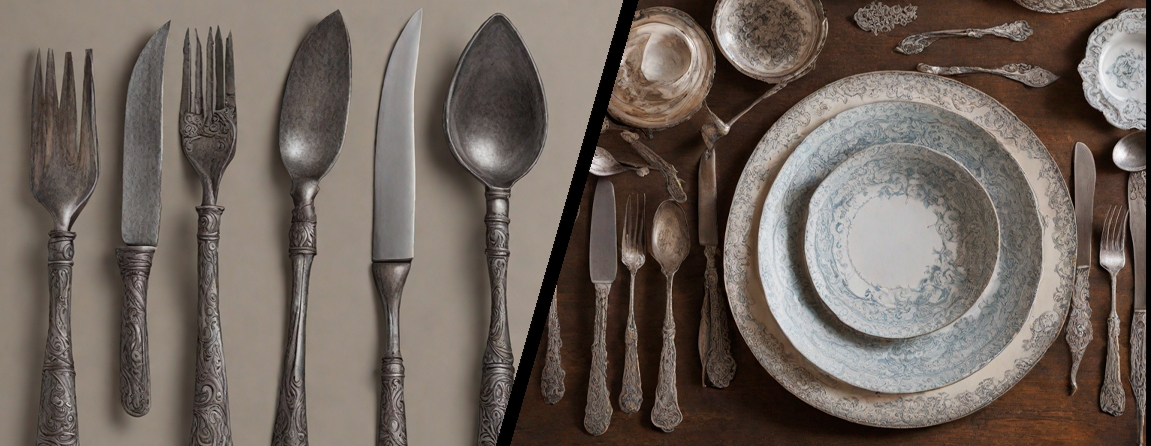
The Table as a Social Ritual and Status Marker
Sharing a meal in the Middle Ages was a social act full of meaning. Especially at court, an elaborate etiquette developed where the arrangement of the seats and the quality of the utensils revealed each diner’s status. Nobles were already using specialized tools during the Early Middle Ages, while common folk continued to eat mainly with their hands. Monasteries also played a key role, developing a refined table culture with prayers and readings, which influenced secular customs.
The Beginnings: The Multipurpose Knife and Hands
Between the years 500 and 1000 AD, the knife was king of the utensils. Each person had their own knife, which served not only for eating, but also as a tool and, occasionally, as a weapon. These early knives were simple, with iron blades and wooden or bone handles, and their shape evolved from pointed blades to wider table knives. Eating with fingers was the norm, and a practice cultivated with specific rules. For example, only the first three fingers of the right hand were used, while the left held the cup or plate. Wooden spoons were the first specialized utensils to appear, mainly in monasteries, for soups and porridges. Local artisans, such as wood carvers and blacksmiths, were in charge of producing these early utensils.
Medieval food was mostly consumed with the help of spoons, although it was not common to use a utensil in each hand. In fact, the knife at the table was a key piece, but it was not usually included with the plate, as each guest was expected to bring their own. The most common practice was to share cups and vessels, which was considered a high etiquette privilege at banquets. It was also good manners to break bread or serve a piece from the central dish of meat to a neighboring diner. Before the meal, guests were offered ewer and towels to wash their faces and hands, a purification ritual marking the start of the banquet.
Refinement in the Early Middle Ages: The Birth of the Primitive Fork
The courtly culture of the Early Middle Ages brought significant changes. Specialized table knives emerged, slimmer and with blades optimized for different foods, such as wider versions for meat and narrower ones for fish. The quality of materials and craftsmanship reflected the owner’s status, with elaborately crafted handles of precious woods, ivory or horn, and metal inlay decorations.
A key innovation of the era was the introduction of the primitive fork. Originating from the Byzantine cultural sphere and brought to Western Europe via trade routes, this single-pronged instrument was used to spear and serve pieces of meat. Its use was initially restricted to the nobility, functioning as a symbol of status.
The Late Medieval Period: The Fork Makes Its Way
The Late Middle Ages witnessed a fundamental change with the appearance of the first two-pronged forks, which became popular in Italy first, thanks to Venetian trading houses. The eating fork was not widely used in medieval Europe and its use did not spread until the modern era. In its beginnings, it was only common in Italy, largely because it was used with pasta. Even so, it was not until the fourteenth century that the fork became common among all social classes. The Byzantine influence, where forks were already common, was notable in the courts of Western Europe, establishing standards that endure until today.
Although there was initial resistance, the acceptance of the fork grew, especially in prosperous cities. Table manners became even more refined, and the proper use of cutlery became a sign of social distinction. The role of the carver gained importance, with specialized sets of cutlery for the artistic carving of meat. The wealthy urban population followed noble customs, while in the countryside, the simple wooden spoon and a basic knife remained the main utensils until the end of the Middle Ages.
Materials and Craftsmanship of Medieval Cutlery
The manufacture of medieval cutlery and utensils required great skill. Artisans demonstrated a high level of expertise by combining different materials to create functional and aesthetic tools.
Wood: The Essential Material
It was the most accessible material for all social classes. Hard woods such as beech and maple were used for spoons and bowls, and oak for cutting boards due to its hardness and resistance. Wooden objects were carved and turned, and protected with oils to prolong their useful life.
Metals: From Functionality to Luxury
Iron and steel were the basis for knives. Blacksmiths mastered the art of forging and tempering blades. For the nobility, silver was the preferred material, and pure gold or gilded silver was reserved for the highest aristocracy, serving as symbols of status. Copper and bronze were common for cauldrons due to their thermal conductivity.
Horn and Bone: Natural Versatility
These were versatile materials, by-products of livestock, easy to work, and with good resistance. They were used for knife handles, spoons, and drinking cups. The care of these objects was essential for their durability; for example, horn objects required gentle treatment with beeswax to protect their surface.
Other Materials: Ceramics, Pewter, and Glass
- Ceramics: Ceramics production was basic. Simple earthenware was porous and often glazed. Higher quality gray ceramics and stoneware offered better impermeability and durability.
- Pewter: With the rise of the urban bourgeoisie, pewter tableware became a distinguishing feature of the well-to-do middle classes, positioning itself between wood and precious metals.
- Glass: At first reserved for the nobility, glass production expanded to urban manufactures, though its use remained a luxury.
Regional Variations and the Legacy of Cutlery
The culture of cutlery also showed regional differences. In Northern Europe, wood carving was prominent, while Hanseatic cities excelled in metallurgy. The Mediterranean, with Byzantine and Eastern influences, developed artistic styles that were traded as luxury goods. Medieval developments in cutlery have influenced table culture to this day. Many of the basic forms that emerged then still determine modern cutlery design. The deep relationship between material culture and social development is clearly reflected in the history of cutlery, allowing us to reconstruct the living environments of different social groups.
If you were fascinated by this journey into the past, we invite you to relive history at your own table. Discover our exclusive collection of medieval cutlery and medieval kitchenware. Immerse yourself in the craftsmanship of a golden era and acquire unique pieces that will transport you to the elegance and history of noble banquets.

